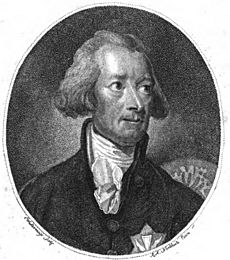Hans Moritz von Brühl facts for kids
Hans Moritz von Brühl (born December 20, 1736 – died June 9, 1809) was a smart German man who worked as a diplomat and loved studying the stars (an astronomer). He lived most of his life in London, England. There, people knew him as John Maurice, Count of Brühl.
Contents
A Life of Learning and Diplomacy
Hans Moritz was born in a place called Wiederau in Saxony (which is now part of Germany). His father was F. W. Graf von Brühl, and his uncle was a famous statesman named Heinrich von Brühl.
When he was young, Hans Moritz studied in Leipzig. He became good friends with Christian Gellert, a well-known writer. In 1755, when he was just 18, Hans Moritz started working in diplomacy in Paris. Diplomacy is about how countries talk and work together.
Later, in 1764, he became a special ambassador for Saxony in London. This meant he was the main representative for his country in England.
His Love for Astronomy
Hans Moritz loved astronomy, which is the study of stars, planets, and space. He helped many people interested in this field. For example, he hired Franz Xaver von Zach as a tutor. Franz Xaver later became a famous astronomer himself.
In 1785, Brühl and Von Zach used special tools, a Hadley's sextant and a chronometer (a very accurate clock), to figure out the exact locations (latitudes and longitudes) of cities like Brussels, Frankfort, Dresden, and Paris.
Around 1787, Brühl built a small observatory (a building for observing stars) at his home in Harefield. There, he set up a special telescope called an astronomical circle, made by Jesse Ramsden. This was one of the first of its kind in England. He was also good friends with William Herschel, another famous astronomer who discovered the planet Uranus. Brühl helped share news of new discoveries with other scientists.
He also supported people who made very accurate clocks, like Thomas Mudge.
In 1765, Hans Moritz von Brühl was chosen to be a member of the Royal Society. This is a very old and respected group of scientists in England. He was also part of the Saxon privy council and a knight. He stayed in England for the rest of his life, except for one trip home in 1785. He passed away in London on June 9, 1809, when he was 72 years old.
What He Wrote
Hans Moritz von Brühl wrote several books and papers, mostly about astronomy and how countries manage their money (political economy). Here are some of his works:
- 'Recherches sur divers Objets de l'Économie Politique,’ Dresden, 1781 (This was about political economy).
- 'Three Registers of a Pocket Chronometer,’ London, 1785 (About accurate clocks).
- 'Latitudes and Longitudes of several Places ascertained,’ London, 1786 (About finding locations on Earth).
- 'Nouveau Journal du Chronomètre,’ fol., London, 1790 (Another work about clocks).
- 'On the Investigation of Astronomical Circles,’ London, 1794 (About the special telescope he used).
- 'A Register of Mr. Mudge's Timekeepers,’ London, 1794 (More about accurate clocks).
He also wrote articles for science journals like Johann Elert Bode's Jahrbuch.
His Family
Hans Moritz von Brühl was married twice. First, in 1767, he married Alicia Maria. She was a countess and the daughter of George Carpenter, 2nd Baron Carpenter. Alicia passed away in 1794, and they had one daughter together.
Second, in 1796, he married Mary Chowne. She was the daughter of Thomas Chowne.
A Skilled Chess Player
Besides all his work in diplomacy and astronomy, "Count de Bruhl" was also known as one of the best chess players of his time. He played alongside famous players like Philidor and George Atwood.


